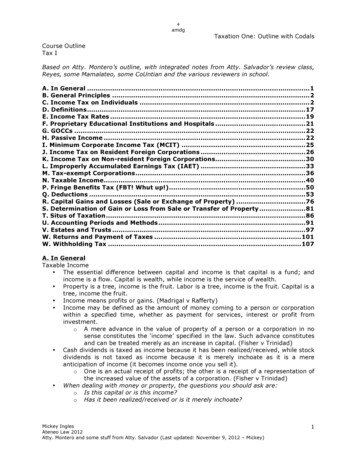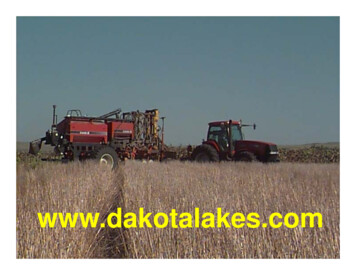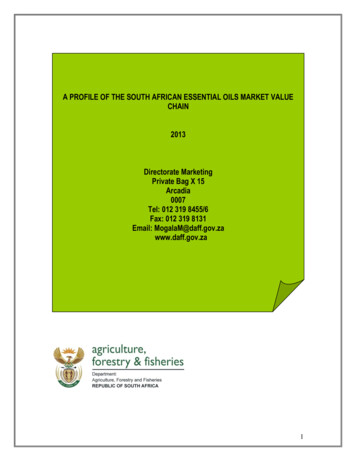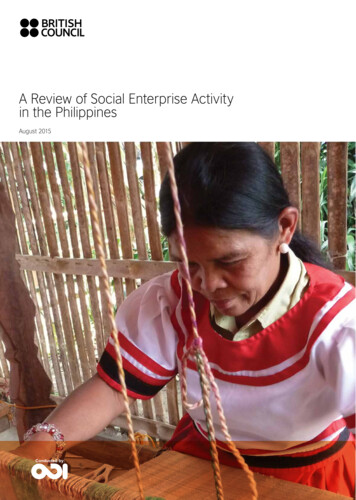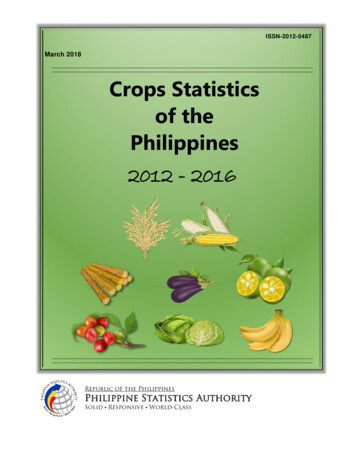
Transcription
ISSN-2012-0487March 2018Crops Statisticsof thePhilippines2012 - 2016Republic of the PhilippinesPhilippine Statistics AuthoritySolid Responsive World-Class
Crops Statistics of the Philippines2012 - 2016Crops Statisticsof the Philippines2012 – 2016Republic of the PhilippinesPhilippine Statistics AuthoritySolid Responsive World-Class
Crops Statistics of the Philippines2012 - 2016REPUBLIC OF THE PHILIPPINESPRESIDENT RODRIGO R. DUTERTEREPUBLIC OF THE PHILIPPINESPHILIPPINE STATISTICS AUTHORITYLISA GRACE S. BERSALES, Ph.D.UndersecretaryNational Statistician and Civil Registrar GeneralCopyright 2018 by Philippine Statistics AuthorityPSA CVEA Building, East Avenue, DilimanQuezon City, Philippinesii
Crops Statistics of the Philippines2012 - 2016FOREWORDThis is the Crops Statistics of the Philippines, an annual publication of thePhilippine Statistics Authority (PSA). This publication is the integration oftwo (2) previously existing PSA publications, namely, “Major Crops Statistics of thePhilippines” and “Crops Statistics of the Philippines (National and Regional)”.This report presents annual statistics on production, area planted/harvested, and numberof bearing trees/hills of 47 crops, with national and regional levels of disaggregation. Abrief description and analysis of the trends of the statistics are also included in thispublication. The reference period is from 2012 to 2016.The crops covered in this publication are classified into four (4) commodity groupings,namely, Cereals, Fruit Crops, Non-Food and Industrial Crops, and Vegetables andRootcrops. In the case of banana, mango, coffee, and tobacco, statistics are furtherdisaggregated by major variety.This report was prepared by the Crops Statistics Division (CSD) of the PSA. It serves asa ready reference for various stakeholders in the crops subsector of agriculture. The PSAcontinuously pursues the improvement of the delivery of its products and services.Comments and suggestions from the readers are welcome for further improvement of thispublication.LISA GRACE S. BERSALES, Ph.D.UndersecretaryNational Statistician and Civil Registrar GeneralQuezon City, PhilippinesMarch 2018iii
Crops Statistics of the Philippines2012 - 2016TABLE OF CONTENTSAdministrative PageiiForewordiiiTable of ContentsivBackgroundxI. HighlightsA. CerealsPalayCorn24B. Fruit CropsBananaCalamansiMangoPineappleOther Fruit Crops79101213C. Non-Food and Industrial CropsAbacaCoconutCoffeeRubberSugarcaneTobaccoOther Non-Food and Industrial Crops16171820212224D. Vegetables and RootcropsCabbageCassavaEggplantGarlicMung Bean/MongoOnionPeanutSweet Potato/CamoteTomatoOther Vegetables and Rootcrops26272829303132333435iv
Crops Statistics of the Philippines2012 - 2016II. Statistical TablesA. National1.11.21.3Volume of Production for Selected Crops, Philippines: 2012-2016Area Planted/Harvested for Selected Crops, Philippines: 2012-2016Number of Bearing Trees/Hills/Tappable Trees for Selected Crops,Philippines: 2012-2016404244Volume of Production for Palay, by Region: 2012-2016Area Planted/Harvested for Palay, by Region: 2012-2016Volume of Production for Irrigated Palay, by Region: 2012-2016Area Planted/Harvested for Irrigated Palay, by Region: 2012-2016Volume of Production for Rainfed Palay, by Region: 2012-2016Area Planted/Harvested for Rainfed Palay, by Region: 2012-2016Volume of Production for Corn, by Region: 2012-2016Area Planted/Harvested for Corn, by Region: 2012-2016Volume of Production for White Corn, by Region: 2012-2016Area Planted/Harvested for White Corn, by Region: 2012-2016Volume of Production for Yellow Corn, by Region: 2012-2016Area Planted/Harvested for Yellow Corn, by Region: 2012-2016464647474848494950505151Volume of Production for Banana, By Region: 2012-2016Area Planted/Harvested for Banana, by Region: 2012-2016Number of Bearing Hills for Banana, by Region: 2012-2016Volume of Production for Banana Cavendish, by Region: 2012-2016Area Planted/Harvested for Banana Cavendish, by Region: 2012-2016Number of Bearing Hills for Banana Cavendish, by Region: 2012-2016Volume of Production for Banana Lakatan, by Region: 2012-2016Area Planted/Harvested for Banana Lakatan, by Region: 2012-2016Number of Bearing Hills for Banana Lakatan, by Region: 2012-2016Volume of Production for Banana Saba, by Region: 2012-2016Area Planted/Harvested for Banana Saba, by Region: 2012-2016Number of Bearing Hills for Banana Saba, by Region: 2012-2016Volume of Production for Calamansi, by Region: 2012-2016Area Planted/Harvested for Calamansi, by Region: 2012-2016Number of Bearing Trees for Calamansi, by Region: 2012-2016535353545454555555565656575757B. bC. Fruit 5.15.25.3v
Crops Statistics of the Philippines2012 - 14.214.315.115.215.316.116.2Volume of Production for Durian, by Region: 2012-2016Area Planted/Harvested for Durian, by Region: 2012-2016Number of Bearing Trees for Durian, by Region: 2012-2016Volume of Production for Lanzones, by Region: 2012-2016Area Planted/Harvested for Lanzones, by Region: 2012-2016Number of Bearing Trees for Lanzones, by Region: 2012-2016Volume of Production for Mandarin, by Region: 2012-2016Area Planted/Harvested for Mandarin, by Region: 2012-2016Number of Bearing Trees for Mandarin, by Region: 2012-2016Volume of Production for Mango, by Region: 2012-2016Area Planted/Harvested for Mango, by Region: 2012-2016Number of Bearing Trees for Mango, by Region: 2012-2016Volume of Production for Mango Carabao, by Region: 2012-2016Area Planted/Harvested for Mango Carabao, by Region: 2012-2016Number of Bearing Trees for Mango Carabao, by Region: 2012-2016Volume of Production for Mangosteen, by Region: 2012-2016Area Planted/Harvested for Mangosteen, by Region: 2012-2016Number of Bearing Trees for Mangosteen, by Region: 2012-2016Volume of Production for Orange, by Region: 2012-2016Area Planted/Harvested for Orange, by Region: 2012-2016Number of Bearing Trees for Orange, by Region: 2012-2016Volume of Production for Papaya, by Region: 2012-2016Area Planted/Harvested for Papaya, by Region: 2012-2016Number of Bearing Trees for Papaya, by Region: 2012-2016Volume of Production for Pineapple, by Region: 2012-2016Area Planted/Harvested for Pineapple, by Region: 2012-2016Volume of Production for Rambutan, by Region: 2012-2016Area Planted/Harvested for Rambutan, by Region: 2012-2016Number of Bearing Trees for Rambutan, by Region: 2012-2016Volume of Production for Tamarind, by Region: 2012-2016Area Planted/Harvested for Tamarind, by Region: 2012-2016Number of Bearing Trees for Tamarind, by Region: 2012-2016Volume of Production for Watermelon, by Region: 2012-2016Area Planted/Harvested for Watermelon, by Region: 46465656566666767676868686969
Crops Statistics of the Philippines2012 - 2016D. Non-Food and Industrial 4.225.125.225.1a25.2a25.1b25.2bVolume of Production for Abaca (dried raw fiber), by Region: 2012-2016Area Planted/Harvested for Abaca, by Region: 2012-2016Volume of Production for Cacao, by Region: 2012-2016Area Planted/Harvested for Cacao, by Region: 2012-2016Number of Bearing Trees for Cacao, by Region: 2012-2016Volume of Production for Cashew, by Region: 2012-2016Area Planted/Harvested for Cashew, by Region: 2012-2016Number of Bearing Trees for Cashew, by Region: 2012-2016Volume of Production for Coconut (with husk), by Region: 2012-2016Area Planted/Harvested for Coconut, by Region: 2012-2016Number of Bearing Trees for Coconut, by Region: 2012-2016Volume of Production for Coffee (dried berries), by Region: 2012-2016Area Planted/Harvested for Coffee, by Region: 2012-2016Number of Bearing Trees for Coffee, by Region: 2012-2016Volume of Production for Coffee Arabica, by Region: 2012-2016Area Planted/Harvested for Coffee Arabica, by Region: 2012-2016Number of Bearing Trees for Coffee Arabica, by Region: 2012-2016Volume of Production for Coffee Excelsa, by Region: 2012-2016Area Planted/Harvested for Coffee Excelsa, by Region: 2012-2016Number of Bearing Trees for Coffee Excelsa, by Region: 2012-2016Volume of Production for Coffee Liberica, by Region: 2012-2016Area Planted/Harvested for Coffee Liberica, by Region: 2012-2016Number of Bearing Trees for Coffee Liberica, by Region: 2012-2016Volume of Production for Coffee Robusta, by Region: 2012-2016Area Planted/Harvested for Coffee Robusta, by Region: 2012-2016Number of Bearing Trees for Coffee Robusta, by Region: 2012-2016Volume of Production for Oil Palm (fresh fruit bunch), by Region: 2012-2016Area Planted/Harvested for Oil Palm, by Region: 2012-2016Number of Bearing Trees for Oil Palm, by Region: 2012-2016Volume of Production for Rubber (cuplump), by Region: 2012-2016Area Planted/Harvested for Rubber, by Region: 2012-2016Number of Tappable Trees for Rubber, by Region: 2012-2016Volume of Production for Sugarcane, by Region: 2012-2016Area Planted/Harvested for Sugarcane, by Region: 2012-2016Volume of Production for Tobacco (dried leaves), by Region: 2012-2016Area Planted/Harvested for Tobacco, by Region: 2012-2016Volume of Production for Tobacco Native, by Region: 2012-2016Area Planted/Harvested for Tobacco Native, by Region: 2012-2016Volume of Production for Tobacco Virginia, by Region: 2012-2016Area Planted/Harvested for Tobacco Virginia, by Region: 777878787979798080808181818282838384848585
Crops Statistics of the Philippines2012 - 2016E. Vegetables and 3.2Volume of Production for Asparagus, by Region: 2012-2016Area Harvested for Asparagus, by Region: 2012-2016Volume of Production for Broccoli, by Region: 2012-2016Area Harvested for Broccoli, by Region: 2012-2016Volume of Production for Cabbage, by Region: 2012-2016Area Harvested for Cabbage, by Region: 2012-2016Volume of Production for Carrots, by Region: 2012-2016Area Harvested for Carrots, by Region: 2012-2016Volume of Production for Cassava, by Region: 2012-2016Area Harvested for Cassava, by Region: 2012-2016Volume of Production for Cauliflower, by Region: 2012-2016Area Harvested for Cauliflower, by Region: 2012-2016Volume of Production for Eggplant, by Region: 2012-2016Area Planted for Eggplant, by Region: 2012-2016Volume of Production for Garlic (bulb), by Region: 2012-2016Area Harvested for Garlic, by Region: 2012-2016Volume of Production for Ginger, by Region: 2012-2016Area Harvested for Ginger, by Region: 2012-2016Volume of Production for Bottle Gourd, by Region: 2012-2016Area Harvested for Bottle Gourd, by Region: 2012-2016Volume of Production for Snap Beans/Habitchuelas, by Region: 2012-2016Area Harvested for Snap Beans/Habitchuelas, by Region: 2012-2016Volume of Production for Lettuce, by Region: 2012-2016Area Harvested for Lettuce, by Region: 2012-2016Volume of Production for Mung Bean/Mongo, by Region: 2012-2016Area Harvested for Mung Bean/Mongo, by Region: 2012-2016Volume of Production for Lady's Finger/Okra, by Region: 2012-2016Area Harvested for Lady's Finger/Okra, by Region: 2012-2016Volume of Production for Onion (matured bulb), by Region: 2012-2016Area Harvested for Onion, by Region: 2012-2016Volume of Production for Peanut, by Region: 2012-2016Area Harvested for Peanut, by Region: 2012-2016Volume of Production for Chinese Pechay, by Region: 2012-2016Area Harvested for Chinese Pechay, by Region: 2012-2016Volume of Production for Native Pechay, by Region: 2012-2016Area Harvested for Native Pechay, by Region: 696979798989999100100101101102102103103104104
Crops Statistics of the Philippines2012 - 201644.144.245.145.246.146.247.147.248.148.2Volume of Production for Sweet Potato/Camote, by Region: 2012-2016Area Harvested for Sweet Potato/Camote, by Region: 2012-2016Volume of Production for Taro/Gabi, by Region: 2012-2016Area Harvested for Taro/Gabi, by Region: 2012-2016Volume of Production for Tomato, by Region: 2012-2016Area Planted for Tomato, by Region: 2012-2016Volume of Production for White/Irish Potato, by Region: 2012-2016Area Harvested for White/Irish Potato, by Region: 2012-2016Volume of Production for Greater Yam/Ubi, by Region: 2012-2016Area Harvested for Greater Yam/Ubi, by Region: 2012-2016ix105105106106107107108108109109
Crops Statistics of the Philippines2012 - 2016BACKGROUNDScope and CoverageCrops statistics are generated for 17 regions (including Negros Island Region for 2016).The Palay and Corn Production Survey (PCPS) is the source of data for cereals (palayand corn), while the Crops Production Survey (CrPS) is for all crops other than palay andcorn. Around 300 crops are covered by these surveys. For this publication, informationon 47 crops are reported. These crops are:Commodity GroupingMajor CropsOther CropsCerealsPalay, cornFruit CropsDurian,lanzones,mandarin,Banana, calamansi, mango,mangosteen, orange, papaya,pineapplerambutan, tamarind, watermelonNon-Food and Industrial Abaca,coconut,coffee,Cacao, cashew, oil palmCropsrubber, sugarcane, tobaccoCabbage, cassava, eggplant,garlic, mung bean/mongo,Vegetables and Rootcropsonion, peanut, sweet potato,tomatoAsparagus, broccoli, carrots,cauliflower, ginger, bottle gourd,snap beans/habitchuelas, lettuce,lady’sfinger/okra,Chinesepechay, native pechay, taro/gabi,white/Irish potato, greater yam/ubiSampling MethodologyThe sampling design of the PCPS uses the results of 1991 Census of Agriculture (CAF)as the sampling frame. The survey domain is the province. It employs a replicated twostage stratified sampling design. The barangay is the primary sampling unit, which wasselected using probability proportional to size scheme. The farming household serves asthe secondary sampling unit, which was selected systematically.A non-probability survey is employed for the CrPS. A “5 by 5” design was used in theselection of samples, with the province being the survey domain. The top five (5)producing municipalities of a certain crop are chosen from each province. From each ofthese municipalities, five (5) sample farmers are selected as respondents. In this twostage design, the municipalities serves as the primary sampling units while the farmersare the secondary sampling unit.x
Crops Statistics of the Philippines2012 - 2016Data CollectionFor PCPS, data collection is conducted quarterly during the first 12 days of the monthafter the reference quarter. For CrPS, data collection is also conducted quarterly, duringthe last ten (10) days of the middle month of the quarter. Both surveys gather data onproduction and area planted/harvested. For CrPS, data on the number of bearingtrees/hils are included.Data Review and ValidationData review and validations are conducted quarterly to ascertain the accuracy of the dataproduced by the surveys. The data review and validation process starts at the ProvincialStatistics Office (PO), after the data processing. All provincial estimates undergo furtherdata review and validations at the regional level, conducted by personnel at the RegionalStatistical Services Office (RSSO).All validated provincial and regional estimates are submitted to the Crops StatisticsDivision (CSD) for final review which is conducted during the National Data Review(NDR). Consultations and discussions between representatives from the RSSO andpersonnel from the CSD are held before officially releasing the statistics.Concepts and DefinitionsThe following concepts and definitions are used in the generation of statistics for crops.Area Harvested – actual area from which harvests are realized. This excludes crop areawhich were totally damaged. It may be smaller than the area planted. In crops statistics,this applies to temporary crops.Area Planted – actual physical area planted. This generally applies to area reported forpermanent crops and multi-harvest temporary crops.Bearing Trees/Hills – number of trees/hills where harvesting has been made in the pastand may or may not have borne fruits (productive) during the reference period due tocyclical production pattern of the crop. Hills applies to banana.Crop Production – the quantity produced and actually harvested for a particular cropduring the reference period. It includes those harvested but damaged, stolen, given away,consumed, given as harvester’s share, reserved, etc. Excluded are those produced butnot harvested due to low price, lack of demand and force majeure or fortuitous events,etc.xi
Crops Statistics of the Philippines2012 - 2016Effective Area Harvested – the actual area which is counted as many times as it wasplanted and harvested to same crops during the reference period. This concept appliesto the harvest area reported for mono harvest temporary crops such as rice, corn, rootcrops and tubers, and pechay.High Yielding Variety – an improved cultivated variety with significantly higher yield andbetter quality under specific environment and improved farming conditions and practicesthan the traditional seed varieties being used; any agricultural crop variety that can equalor exceed the yield of the current commercially grown variety in a particular locality. HYVmay be locally or foreign bred.Industrial Crops – crops that are used as inputs to other industries.Examples are: rubber, castor beans, abaca, and oil palm.Irrigated Palay – palay crop which receives irrigation water during its development.Irrigation may be available through artificial means such as gravity, force, power pumps,etc. It is not solely confined to lowland but also to high places where paddies are built forplanting rice.Major Crops – 21 crops in the Philippines which collectively account for more than60 percent of the total crop production. These include palay, corn, banana, calamansi,mango, pineapple, abaca, coffee, coconut, rubber, sugarcane, tobacco, cabbage,cassava, eggplant, garlic, mungbean/mongo, onion, peanut, sweet potato, and tomato.Minor Crops – all remaining crops other than the major crops. This group accounts forabout 40 percent of the total crop production.Non-Food Crops – are crops other than those used for food consumption. These arecrops grown for their aesthetic values such as ornamental plants and cutflowers. Thesealso include agriculture-derived products such as rice hay and coconut leaves.Permanent/Perennial Crops – are crops which occupy the land for long period and donot need to be replaced after each harvest such as fruit trees, shrubs, nuts, etc. Thesecrops may be productive or fruit-bearing crops.Examples are: avocado, coffee, coconut and other fruit trees.Priority Crops – identified national banner crops and various regional priority crops ofthe then Key Commercial Crops Development Program (KCCDP), High Value CropsDevelopment Program (HVCDP), and now the Key Commodity Road Maps of theDepartment of Agriculture, which are being developed because of its industrial andcommercial potentials.xii
Crops Statistics of the Philippines2012 - 2016Rainfed Palay – palay crop which depends solely upon rainfall for its water supply;usually planted through transplanting or direct seeding in fields with dikes which retainwater. There may be dikes in the field to hold water in the case of lowland-rainfed, or nonein the case of upland palay.Rootcrops – crops with well-developed underground edible roots. These are classifiedinto roots and tubers. Roots which are more starchy and rich in carbohydrates includegabi, ubi, and white potato. Tubers include beets, radish, carrots, and turnips.Temporary Crops – crops which are grown seasonally, have growing cycle less thanone year, and must be sown and planted again for production after each harvest.Vegetable Crops – mostly temporary crops which are either classified agronomically assuch or based on purpose for which they are used. For instance, fruit crops such asjackfruit and green papaya are classified as vegetables during its young stage.White Corn – corn grown and used mainly for human consumption and manufacture ofcorn by-products such as cornstarch, corn oil, syrup, dextrin, glucose, gluten, etc.Yellow Corn – corn used mainly as feed grains; includes all types of corn other thanwhite.Yield – indicator of productivity derived by dividing total production by the area harvested.Standard symbols, units of measure, and acronyms used in this publicationm.t.metric tonsha.hectarekg.kilogramHYVHigh Yielding VarietyARMMAutonomous Region in Muslim MindanaoCALABARZONCavite, Laguna, Batangas, Rizal, QuezonCARCordillera Administrative RegionNIRNegros Island RegionMIMAROPAOccidental Mindoro, Oriental Mindoro, Marinduque, Romblon, PalawanSOCCSKSARGENSouth Cotabato, Cotabato, Cotabato City, Sultan Kudarat, Saranggani,General Santos Cityxiii
Crops Statistics of the Philippines2012 - 2016Highlights
Crops Statistics of the Philippines2012 - 2016Cereals
Crops Statistics of the Philippines2012 - 2016PALAYPalay production during the period2012-2016 declined from 18.03 million m.t. in2012, to 17.63 million m.t. in 2016, at anannual average rate of 0.5 percent. Likewise,totalharvestareadecreasedfrom4.69 million hectaresin2012 to4.56 million hectares in 2016, or by an annualaverage rate of 0.7 percent (Figure 1). Duringthis period, the country’s palay productionpeaked in 2014 at 18.97 million m.t. andgradually went down from 2015 to 2016.Palay output in 2016 was below the2015 level of 18.15 million m.t. by2.9 percent. About 76.8 percent of the outputcame from irrigated areas and the remainingfrom rainfed areas (Figure 2). Similarly,harvest area decreased by 2.2 percent.These were attributed to the effects ofTyphoons “Lando” and “Nona” in the later partof 2015, dry spell and drought in the firstsemester of 2016, and Typhoons “Karen” and“Lawin” in Northern Luzon regions in thefourth quarter of 2016.Substantial decrements in productionwere noted in Cagayan Valley (Cagayan andIsabela), Western Visayas (Iloilo), CentralVisayas (Bohol), Zamboanga Peninsula(ZamboangadelNorte)andSOCCSKSARGEN (North Cotabato).Central Luzon registered the highestproduction with 3.34 million m.t. output in2016 or 19.0 percent of the country’s totalpalay production. The other top producingregions were Cagayan Valley which shared13.2 percent; Ilocos Region, 10.2 percent;and Western Visayas, 8.2 percent (Figure 3).These regions accounted for 46.7 percent ofthe country’s total harvest area (Figure 4).2
Crops Statistics of the Philippines2012 - 2016Palay production in irrigated areaspeaked at 13.54 million m.t. level in 2016.The top three (3) producing regions wereCentral Luzon with 3.11 million m.t.;Cagayan Valley, 2.18 million m.t. andIlocosRegion,1.31millionm.t.The collective output from these regionsaccounted for 48.8 percent of the totalirrigated palay production in 2016(Figure 5).In rainfed areas, palay productionregistered at 4.09 million m.t. in 2016.Western Visayas was the top producerwith 18.8 percent share to total rainfedpalay output. It was followed byIlocos Region and Eastern Visayas with12.2 percent and 10.1 percent shares,respectively (Figure 6).3
Crops Statistics of the Philippines2012 - 2016CORNCorn production from 2012 to 2016decreased at an average annual rate of0.6 percent, from 7.41 million m.t. in 2012to 7.22 million m.t. in 2016. Similarly, areaharvested fell at annual average rate of1.1 percent during the same referenceperiod (Figure 7).In 2016, production decreased by4.0 percent from the 2015 output of7.52 million m.t. Of this, yellow corn shared72.0 percent, while the remaindercomprised of white corn (Figure 8).Likewise, harvest area was cut-back to2.48 million hectares from the previousyear’s level of 2.56 million hectares.These were adversely affected by dry spelland drought in the first semester, and byTyphoons “Karen” and “Lawin” in CAR andCagayan Valley during the last quarter.Decrements in production werelarge in CAR (Ifugao), Cagayan Valley(Cagayan and Isabela), Western Visayas(Iloilo), SOCCSKSARGEN (North andSouthCotabato)andARMM(Maguindanao).The top corn producing region of thecountry in 2016 was Cagayan Valley at1.68 million m.t. output, which shared23.3 percent to total corn production.This was followed by Northern Mindanaowith 16.9 percent and SOCCSKSARGENwith 15.8 percent. The combined outputfrom these regions accounted for56.0 percent of the country’s total cornproduction (Figure 9). Also, CagayanValley had the largest area harvested at414.45 thousand hectares or 16.7 percentof the country’s total area harvested forcorn in 2016 (Figure 10).4
Crops Statistics of the Philippines2012 - 2016White corn production was recorded at2.02 million m.t. in 2016. Northern Mindanaowas the top producer at 463.29 thousand m.t.,equivalent to 22.9 percent of the country’stotal white corn output. The other topproducing regions were ARMM which shared17.0 percent and SOCCSKSARGEN, with10.8 percent (Figure 11).On the other hand, yellow cornproduction at 5.20 million m.t. was72.0 percent of the country’s corn output in2016. Cagayan Valley remained the highestyellow corn producing region whichcontributed 31.6 percent to the country’sproduction in 2016. SOCCSKSARGENranked second with 17.8 percent, followed byNorthern Mindanao with 14.6 percent(Figure 12).5
Crops Statistics of the Philippines2012 - 2016Fruit Crops
Crops Statistics of the Philippines2012 - 2016BANANABananaproductiondecreased annually at anaverage rate of 0.8 percent,from 9.23 million m.t. in 2012to 8.90 million m.t. in 2016.During the same period, areaplanted slowed down annuallyat an average rate of0.6percent,from454.26 thousand hectaresin2012to442.87 thousand hectares in2016. On the other hand, thenumber of bearing hillsincreased annually at anaverage rate of 0.3 percent,from 280.96 million bearinghills in 2012 to 284.42 millionbearing hills in 2016 (Figure 13).Total banana production in 2016 was 8.90 million m.t., 2.0 percent lower than the2015 output of 9.08 million m.t. This was attributed to lower yield due to drought in thefirst semester. Smaller fruits developed and lesser hills bore fruits in SOCCSKSARGEN(North Cotabato) and Zamboanga Peninsula (Zamboanga City and Sibugay).Total area planted to banana in 2016 was estimated at 442.87 thousand hectares,0.1 percent lower than the 2015 level of 443.37 thousand hectares. Likewise, the numberof bearing hills decreased by 0.9 percent, from 286.87 million in 2015 to 284.42 million in2016.The decrease in number of bearing hills was reported as the effect ofTyphoon “Lando” in October 2015 in Cagayan Valley (Isabela and Quirino). Likewise,Typhoon “Nona” in December 2015 caused heavy damages in MIMAROPA(Mindoro Oriental).Davao Region was the top producer of banana in 2016 which was registered at3.48 million m.t. or 39.1 percent of total banana production. Next was Northern Mindanaowith 20.9 percent, followed by SOCCSKSARGEN, 11.5 percent; ARMM, 6.0 percent; andCagayan Valley, 4.0 percent (Figure 14).7
Crops Statistics of the Philippines2012 - 2016Banana cavendish variety held the highest share of 52.1 percent to the totalbanana production in 2016. Saba variety ranked second at 27.8 percent, while lakatanvariety had 10.1 percent share (Figure 15).Proudction for banana cavendish went down at an annual average rate of0.1 percent, from 4.70 million m.t. in 2012 to 4.64 million m.t. in 2016. Area planted tocavendish variety went up annually at an average rate of 1.3 percent, from82.41 thousand hectares in 2012 to 86.67 thousand hectares in 2016.In 2016, banana cavendish production reached 4.64 million m.t., 1.6 percent higherthan the 4.57 million m.t. level of 2015. Gains in production could be traced to theincreases in the area planted and number of bearing hills harvested from the corporatefarms in Northern Mindanao (Bukidnon) and in Davao Region (Davao Norte).8
Crops Statistics of the Philippines2012 - 2016CALAMANSIFrom 2012-2016, annualcalamansi production decreased atan average rate of 9.1 percent.Similarly, during this period, areaplanted and the number of bearingtrees contracted by an average rateof 1.2 percent and 2.1 percent,respectively (Figure 16).In2016,calamansiproductionregisteredat118.25 thousand m.t., 27.3 percentlower than the 2015 level of162.68thousandm.t.The decrement in output wascaused by the adverse effects ofTyphoon “Nona” in December 2015in MIMAROPA (Oriental Mindoro)and lesser fruits developed due todroughtinSOCCSKSARGEN(North Cotabato). Similarly, areaplanted decreased by 0.8 percentfrom 19.99 thousand hectares in2015 to 19.82 thousand hectares in2016.MIMAROPA remained thetop calamansi producing region andcontributed 35.8 percent to thecountry’s total output in 2016.CALABARZON ranked second with11.0 percent, followed by CentralLuzon, 8.6 percent; ZamboangaPeninsula, 8.5 percent; and DavaoRegion, 7.1 percent (Figure 17).As the top calamansi producing region, MIMAROPA posted the largest areaplanted to calamansi as well as the highest number of bearing trees with shares of33.1 percent and 29.3 percent, respectively.9
Crops Statistics of the Philippines2012 - 2016MANGOMango production grewannually at an average rate of1.7percent,from768.41 thousand m.t. in 2012 to814.06 thousand m.t. in 2016.During the same period, areaplanted slowed down annually at0.1percent,from188.72 thousand hectares in 2012to 187.83 thousand hectares in2016. Number of bearing treesincreased annually at an averagerate of 2.4 percent, from8.80 million bearing trees in 2012to 9.63 million bearing trees in2016 (Figure 18).Mango production in 2016 was 814.1 thousand m.t., lower by 9.8 percent from theprevious year’s level at 902.7 thousand m.t. Reduction in o
1.1 Volume of Production for Selected Crops, Philippines: 2012-2016 40 1.2 Area Planted/Harvested for Selected Crops, Philippines: 2012-2016 42 1.3 Number of Bearing Trees/Hills/Tappable Trees for Selected Crops, Philippines: 2012-2016 44 B. Cereals 2.1 Volume of Production for Palay, by Region: 2012-2016 46

